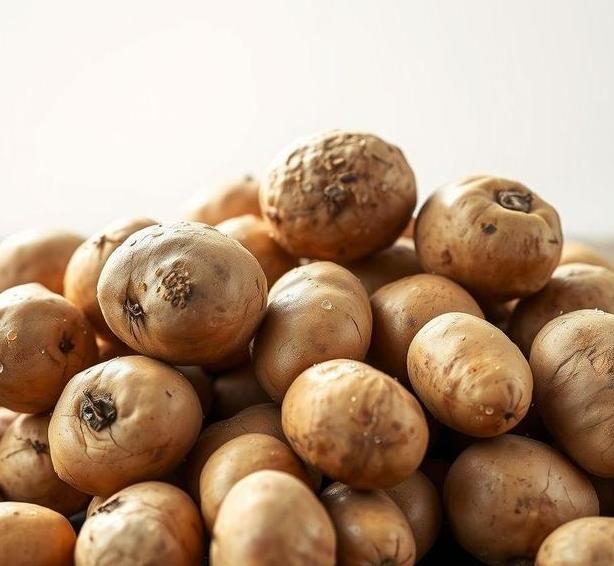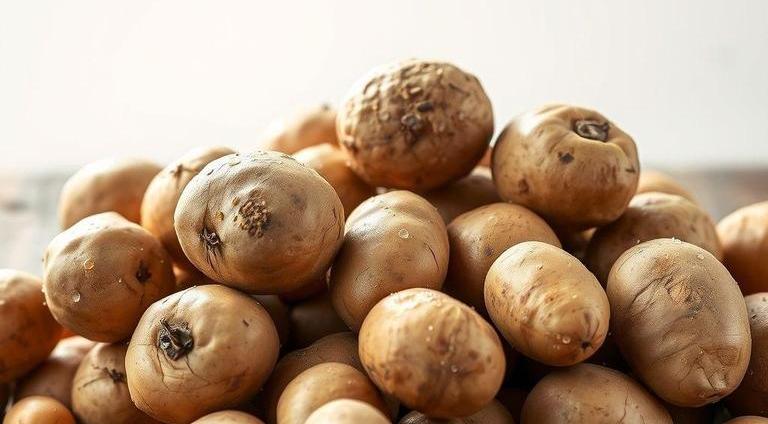Potatoes, those humble and versatile tubers, are a staple in kitchens around the world. From mashed potatoes to fries, baked to boiled, they seem to show up in nearly every cuisine. But despite their durability and long history as a pantry mainstay, we often wonder: can potatoes go bad? And how do we know when they’re no longer safe to eat or cook with?
In this guide, we’ll walk through everything you need to know about potato storage, spoilage signs, and how to make the most of this kitchen essential. You’ll learn why potatoes have such an impressive shelf life, how to store them properly, and how to avoid the unpleasant surprises that come with spoiled spuds.
So, let’s dig into all things potatoes and answer those questions about freshness, shelf life, and more!
Can Potatoes Go Bad?
Yes, potatoes can go bad-but not as easily as some other fresh produce. They are root vegetables, which means they grow underground and are built to last. However, they’re still perishable and can deteriorate over time due to improper storage or environmental factors.
Here’s the thing about potatoes: they have a natural defense mechanism against spoilage, but that doesn’t make them impervious to decay. Whether they’re stored in a warm, humid spot or exposed to too much light, potatoes can start to sprout, shrivel, or develop spots that signal it’s time to toss them.
- Spoilage is gradual: Potatoes don’t spoil immediately after their shelf life is up. They’ll show gradual signs of decay, so if you know what to look for, you can catch them before they’re beyond salvage.
- Ideal conditions: Potatoes last the longest when stored in a cool, dry, and dark environment. If they’re exposed to heat, humidity, or light for extended periods, their quality will deteriorate more quickly.
Shelf Life For Potatoes

Potatoes have a relatively long shelf life compared to most vegetables, but it’s important to note that their longevity depends on various factors, including how they’re stored and whether they’re fresh or already cooked.
Here’s a breakdown of the different shelf lives:
-
Raw Potatoes (Unpeeled, Whole)
- In a cool, dry, dark place: Typically last 2 to 3 months.
- Avoid placing them in the fridge, as cold temperatures can alter their flavor and texture, making them more starchy and prone to sprouting.
-
Raw Potatoes (Peeled Or Cut)
- If peeled or sliced, they last only 1-2 days in the fridge. After that, they start to oxidize, turning brown and becoming mushy.
-
Cooked Potatoes
- Stored in the fridge in an airtight container, cooked potatoes will last around 3-5 days. This includes mashed potatoes, fries, or any leftover baked potato.
-
Frozen Potatoes
- If you’ve blanched and frozen them (without cooking), raw potatoes can last up to 10-12 months. Cooked potatoes like fries or hashbrowns can also be frozen and last for up to 3-4 months.
So, potatoes last longest when kept whole and unpeeled in a proper environment. If you’ve got leftovers, try to consume them within a few days or freeze them for long-term storage.
Common Signs Of Spoilage
Knowing when potatoes have gone bad is key to preventing any unpleasant surprises in the kitchen. Potatoes don’t always show clear-cut signs of spoilage, but they do exhibit some noticeable changes when they’re no longer good to eat.
Here’s a rundown of the most common signs:
-
Sprouts
Sprouts are a clear indication that the potato is past its prime. While sprouted potatoes aren’t necessarily unsafe to eat (you can cut off the sprouts), they tend to have a bitter taste and a decrease in quality. If the sprouts are large or numerous, it’s best to discard the potato.
-
Softness
Fresh potatoes are firm to the touch. If your potato is soft, squishy, or wrinkled, it’s started to break down and is likely no longer good. Some softness can be repaired by cooking the potato immediately, but if it’s mushy throughout, it’s time to toss it.
-
Discoloration
Brown or black spots indicate that the potato has started to spoil. These could be from bruising or a bacterial infection, and they often affect the texture as well. While small discolorations can be cut away, large patches of darkening or blackening mean the potato is past its best.
-
Green Skin
If the potato’s skin turns green, it’s a sign of solanine, a toxic compound that forms when potatoes are exposed to light. Solanine poisoning can cause nausea, vomiting, and headaches. You can peel away the green skin, but if the potato is largely green, it’s safest to discard it.
-
Funky Smell
A sour, rotten, or musty odor is a telltale sign that the potato is spoiled and should be discarded immediately.
-
Mold
Potatoes should never develop visible mold. If you spot any, it’s a sure sign that the potato has gone bad.
How To Store Potatoes?

To keep your potatoes fresh as long as possible, proper storage is essential. The environment in which you store them plays a huge role in how quickly they’ll spoil or sprout.
Here’s how to store potatoes effectively:
-
Cool, Dry, Dark Place
The best storage environment for potatoes is somewhere cool (but not cold), dry, and dark. A pantry or a cupboard away from heat sources is ideal. Direct sunlight can cause potatoes to turn green, so avoid storing them in clear containers.
-
Ventilation Is Key
Potatoes need airflow, so store them in perforated bags, baskets, or mesh containers. This helps prevent moisture buildup, which can lead to rot or mold. Avoid plastic bags that trap moisture.
-
Don’t Store With Onions
While both potatoes and onions are often kept in similar spots in the kitchen, they should never be stored together. Onions release gases that can cause potatoes to sprout faster.
-
Avoid The Fridge
While refrigeration can help preserve some vegetables, it actually does the opposite for potatoes. Cold temperatures (below 40°F / 4°C) turn the starches into sugars, resulting in a weird texture and overly sweet flavor.
-
Keep Potatoes Whole
Potatoes last longer when they’re unpeeled and whole. Cutting or peeling them will speed up spoilage, even when stored properly.
Expert Tips
To maximize the lifespan of your potatoes and avoid wasting any, here are some expert tips:
-
Check Regularly
Potatoes can go bad quickly if one starts to rot. Make it a habit to check your potato stash regularly. If you find any soft or discolored ones, remove them immediately to prevent them from affecting the others.
-
Don’t Refrigerate Cooked Potatoes Right Away
If you’ve cooked potatoes and have leftovers, let them cool down to room temperature first before placing them in the fridge. Storing hot potatoes directly in the fridge can cause condensation, which creates the perfect environment for bacteria to grow.
-
Sprout Prevention
If you have leftover potatoes that you won’t use right away, you can put them in a paper bag with a small apple. The apple emits ethylene gas, which can help slow down sprouting.
-
Freeze For Long-Term Storage
If you have too many potatoes or can’t use them fast enough, freezing is a great option. Be sure to blanch them (boil briefly) before freezing to preserve their texture.
-
Peel And Cook With Care
If your potatoes have some sprouting or minor blemishes, you can still use them. Just peel away any damaged areas and cook them quickly to avoid further degradation.
FAQs
Can Potatoes Go Bad If Left Out?
Yes, potatoes can go bad if left out in warm, humid conditions. They should be stored in a cool, dark, and well-ventilated place to extend their shelf life.
How Long Do Potatoes Last Before Going Bad?
Potatoes typically last 1-2 weeks when stored at room temperature, and up to 2-3 months when stored in a cool, dark, and dry place. However, if they are kept in the refrigerator, they can last longer but may develop a sweeter taste due to starch conversion into sugar.
What Are The Signs That Potatoes Have Gone Bad?
Signs that potatoes have gone bad include a greenish color, sprouting, soft or wrinkled skin, a strong odor, or dark spots. Potatoes that are mushy or have visible mold should also be discarded.
Can You Eat Potatoes With Sprouts?
While small sprouts can be removed, potatoes with large sprouts should not be eaten, as they contain solanine, a toxic compound. Eating sprouted potatoes can cause nausea, vomiting, and other digestive issues.
What Should You Do If Potatoes Turn Green?
If potatoes have turned green, it is best to discard them or remove the green parts, as they contain solanine, a toxic compound. Green coloring indicates exposure to light, which increases solanine levels.
Can You Store Potatoes In The Fridge?
While it is possible to store potatoes in the refrigerator, it is not recommended for long-term storage. The cold temperature can cause the starches to convert into sugars, resulting in a sweeter flavor and potentially affecting the texture. For best results, store potatoes in a cool, dark pantry.
How Can You Prevent Potatoes From Going Bad Quickly?
To prevent potatoes from going bad, store them in a cool (45-50°F), dry, and dark location with good air circulation. Avoid placing them near onions or apples, as these can release gases that accelerate spoilage.
Is It Safe To Eat Potatoes With Black Spots?
Potatoes with small black spots can usually be eaten once the affected areas are cut away. However, if the black spots cover a large portion of the potato, it may indicate rot, and the potato should be discarded.
Can Potatoes Go Bad In The Pantry?
Yes, if stored improperly, potatoes can go bad in the pantry. They should be kept in a cool, dark place with good airflow. Potatoes can sprout, rot, or become mushy if exposed to moisture or excessive warmth.
Can You Freeze Potatoes To Make Them Last Longer?
Yes, you can freeze potatoes, but they should first be cooked or blanched to preserve their texture. Raw potatoes do not freeze well and can turn mushy when thawed.